HINDU FUNERALS, CREMATION AND VARANASI
HINDU FUNERALS, CREMATION AND VARANASI
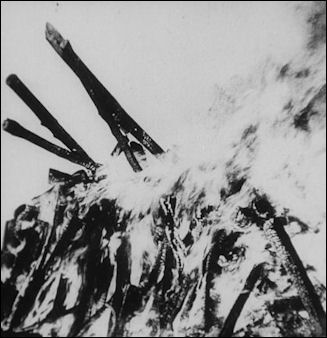
Gandhi cremation
 There are about 3.14 million deaths a year. Most people are cremated. For the part most cremations are still done the way they have been done for centuries, by following the final life ritual called antyesti, outlined in the Grihya Sutras. The average cost of a funeral is $12 to $71.
There are about 3.14 million deaths a year. Most people are cremated. For the part most cremations are still done the way they have been done for centuries, by following the final life ritual called antyesti, outlined in the Grihya Sutras. The average cost of a funeral is $12 to $71. Cremation is an extremely important ritual for Hindus. They believe it releases an individual’s spiritual essence from its transitory physical body so it can be reborn. If it is not done or not done properly, it is thought, the soul will be disturbed and not find its way to its proper place in the afterlife and come back and haunt living relatives. Fire is the chosen method to dispose of the dead because of its association with purity and its power to scare away harmful ghosts, demons and spirits. The fire god Agni is asked to consume the physical body and create its essence in heaven in preparation for transmigration. Cremations are still associated with sacrifices. The god Pushan is asked to accept the sacrifice and guide the soul to its proper place in the afterlife.
Cremation is an extremely important ritual for Hindus. They believe it releases an individual’s spiritual essence from its transitory physical body so it can be reborn. If it is not done or not done properly, it is thought, the soul will be disturbed and not find its way to its proper place in the afterlife and come back and haunt living relatives. Fire is the chosen method to dispose of the dead because of its association with purity and its power to scare away harmful ghosts, demons and spirits. The fire god Agni is asked to consume the physical body and create its essence in heaven in preparation for transmigration. Cremations are still associated with sacrifices. The god Pushan is asked to accept the sacrifice and guide the soul to its proper place in the afterlife. Not everyone is cremated. Holy men, lepers and people with small pox have traditionally been buried, with holy men traditionally buried in a vertical position preserved with salt. Small children under two are not cremated because their soul does not need purifying. In many cases today they are not buried but are taken to the middle of the Ganges or another sacred river and dropped to the river bottom with a weighed stone. Families who can not afford the wood for cremation sometimes throw unburned corpses in the Ganges. In some cases an effigy is burned to symbolize cremation. Few people are buried. These are victims of suicide, murder, or some other kind of violence who, it is believed, have souls that will not rest, no matter what is done to the corpse.
Not everyone is cremated. Holy men, lepers and people with small pox have traditionally been buried, with holy men traditionally buried in a vertical position preserved with salt. Small children under two are not cremated because their soul does not need purifying. In many cases today they are not buried but are taken to the middle of the Ganges or another sacred river and dropped to the river bottom with a weighed stone. Families who can not afford the wood for cremation sometimes throw unburned corpses in the Ganges. In some cases an effigy is burned to symbolize cremation. Few people are buried. These are victims of suicide, murder, or some other kind of violence who, it is believed, have souls that will not rest, no matter what is done to the corpse. Cremation has remained common, possibly because cemeteries are a waste of space. New electric crematoriums are becoming more popular. They are more efficient and cleaner, and save precious fuel and forests.
Cremation has remained common, possibly because cemeteries are a waste of space. New electric crematoriums are becoming more popular. They are more efficient and cleaner, and save precious fuel and forests. Hindus often have little interest in the afterlife.
Hindus often have little interest in the afterlife. Websites and Resources on Hinduism: heart of Hinduism hinduism.iskcon.com/index ; India Divine indiadivine.org ; Hinduism Todayhinduismtoday.com ; ; Religious Tolerance Hindu Page religioustolerance.org/hinduism ; Hinduism Index uni-giessen.de/~gk1415/hinduism ; Hindu Universe hindunet.org ; Wikipedia article Wikipedia ; Oxford center of Hindu Studies ochs.org.uk ; Hinduism Home Pageuwacadweb.uwyo.edu/religionet/er/hinduism ; Hindu Website hinduwebsite.com/hinduindex ; Hindu Gallery hindugallery.com ; Hindusim Today Image Gallery himalayanacademy.com/resources/books/wih/image-library ; India Divine Pictures of Hinduism indiadivine.org/pictures
Websites and Resources on Hinduism: heart of Hinduism hinduism.iskcon.com/index ; India Divine indiadivine.org ; Hinduism Todayhinduismtoday.com ; ; Religious Tolerance Hindu Page religioustolerance.org/hinduism ; Hinduism Index uni-giessen.de/~gk1415/hinduism ; Hindu Universe hindunet.org ; Wikipedia article Wikipedia ; Oxford center of Hindu Studies ochs.org.uk ; Hinduism Home Pageuwacadweb.uwyo.edu/religionet/er/hinduism ; Hindu Website hinduwebsite.com/hinduindex ; Hindu Gallery hindugallery.com ; Hindusim Today Image Gallery himalayanacademy.com/resources/books/wih/image-library ; India Divine Pictures of Hinduism indiadivine.org/picturesEarly Cremations in India
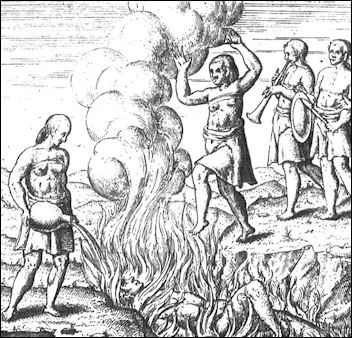
Balinese widow burning in 1597
 It is not clear how and why the custom of cremation evolved. By the time the earliest Hindu texts were written around 1,200 B.C. it was already an established custom. There is some archeological evidence that in the distant past burial was the norm and later cremation with a secondary burial became common place and this gave way to cremation, the dominant custom today.
It is not clear how and why the custom of cremation evolved. By the time the earliest Hindu texts were written around 1,200 B.C. it was already an established custom. There is some archeological evidence that in the distant past burial was the norm and later cremation with a secondary burial became common place and this gave way to cremation, the dominant custom today. From the time of the Rig Veda, which contains passages possibly written as far aback as 2000 B.C., Hindus have cremated the dead although small children and ascetic were sometimes buried and low caste members sometimes buried their own. One passage from the Rig Veda addressed to Jataedas!, the fire that burns that corpse, goes. O Jataedas! When you thoroughly burn this [departed person], Then may you hand him over to the pitris [i.e. heavenly fathers]! When he [the deceased] follows thus [path] that leads to a new life, May he become on that carries out the wishes of the gods
From the time of the Rig Veda, which contains passages possibly written as far aback as 2000 B.C., Hindus have cremated the dead although small children and ascetic were sometimes buried and low caste members sometimes buried their own. One passage from the Rig Veda addressed to Jataedas!, the fire that burns that corpse, goes. O Jataedas! When you thoroughly burn this [departed person], Then may you hand him over to the pitris [i.e. heavenly fathers]! When he [the deceased] follows thus [path] that leads to a new life, May he become on that carries out the wishes of the gods Sometimes animals were sacrificed at the funerals. Another passage from the Rig Veda reads: O Jatavedas! May you burn by your heat the goat that is youre share! May your flame, may your bright light burn that goat; Carry this [departed soul] to the world if this who do good deeds By means of youre beneficent bodies [flames]!
Sometimes animals were sacrificed at the funerals. Another passage from the Rig Veda reads: O Jatavedas! May you burn by your heat the goat that is youre share! May your flame, may your bright light burn that goat; Carry this [departed soul] to the world if this who do good deeds By means of youre beneficent bodies [flames]! It is not known why the custom of cremation was adopted, Some have suggested 1) it is a method of purification, of releasing the soul from a polluted body; 2) it symbolizes the transitory nature of life, of destruction and rebirth; or 3) it eliminated the body as a health risk and doesn’t take up valuable land.
It is not known why the custom of cremation was adopted, Some have suggested 1) it is a method of purification, of releasing the soul from a polluted body; 2) it symbolizes the transitory nature of life, of destruction and rebirth; or 3) it eliminated the body as a health risk and doesn’t take up valuable land.The Soul, Death and Afterlife in Hinduism
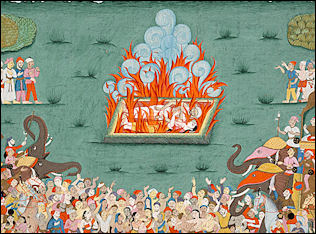
 There is little mourning when a Hindu dies because they believe that once a person is born he or she never dies. Krishna said in the Bhagavad-Gita that "Worn-out garments are shed by the body: worn-out bodies are shed by the dweller within...New bodies are donned by the dweller, like garments.” Death is often viewed in a positive light: as an escape from one life on the road to a better an ultimate moksha (nirvana), shanti (peace) and paramapada (the ultimate place).
There is little mourning when a Hindu dies because they believe that once a person is born he or she never dies. Krishna said in the Bhagavad-Gita that "Worn-out garments are shed by the body: worn-out bodies are shed by the dweller within...New bodies are donned by the dweller, like garments.” Death is often viewed in a positive light: as an escape from one life on the road to a better an ultimate moksha (nirvana), shanti (peace) and paramapada (the ultimate place). Atman (the self or spiritual soul) is seen as a kernel that lies at the center of a large onion and is only revealed after the layers around it—associated with the body, passions and mental powers—are removed in a step by step fashion. The Taittiriya Upanishad defines five layers or sheaths (from the outer to the kernel): 1) the body 2) bio-energy, the equivalent of Chinese qi; 3) mental energy; 4) intuition and wisdom; 5) pure bliss achieved mainly through meditation. These layers can be removed through self actualization and the kernel of eternal bliss can ultimately be realized.
Atman (the self or spiritual soul) is seen as a kernel that lies at the center of a large onion and is only revealed after the layers around it—associated with the body, passions and mental powers—are removed in a step by step fashion. The Taittiriya Upanishad defines five layers or sheaths (from the outer to the kernel): 1) the body 2) bio-energy, the equivalent of Chinese qi; 3) mental energy; 4) intuition and wisdom; 5) pure bliss achieved mainly through meditation. These layers can be removed through self actualization and the kernel of eternal bliss can ultimately be realized. On the subject of death one passage in the Rig Veda reads:
On the subject of death one passage in the Rig Veda reads: When he goes on the path that lead away the breath of life.
Then he will be led by the will of the gods
May your eye go to the sun, you life’s breath to the wind
Go to the sky or the earth, as is your nature.
 The Vedas refer to two paths taken after death: 1) the path of the ancestors, where the deceased travels to a heaven occupied by ancestors and is ultimately reborn; 2) the path of gods, where the deceased enters a realm at the sun and never returns. The latter is the equivalent of reaching nirvana and escaping reincarnation. There is also a reference to a hell-like “pit” where sinners are punished.
The Vedas refer to two paths taken after death: 1) the path of the ancestors, where the deceased travels to a heaven occupied by ancestors and is ultimately reborn; 2) the path of gods, where the deceased enters a realm at the sun and never returns. The latter is the equivalent of reaching nirvana and escaping reincarnation. There is also a reference to a hell-like “pit” where sinners are punished. At death the sheaths break apart one by one, and go their separate ways revealing the atman, which departs the body and goes on a path defined by an individual’s karma. In most cases the individual goes to a niche in the cosmos occupied by his ancestors or to one of the 21 heavens and hells of Hindu cosmology and remains there for duration defined by their karma until he or she is ready to be reborn.
At death the sheaths break apart one by one, and go their separate ways revealing the atman, which departs the body and goes on a path defined by an individual’s karma. In most cases the individual goes to a niche in the cosmos occupied by his ancestors or to one of the 21 heavens and hells of Hindu cosmology and remains there for duration defined by their karma until he or she is ready to be reborn.Hindu Beliefs About Reincarnation
 Reincarnation is viewed as a never-ending set of cycles ( yugas and kalpas ). One may be reincarnated millions of times. The doctrine that the soul repeatedly dies and is reborn is called samsara (Sanskrit for migration). Karma determines what a person is reincarnated as. Escape from the weary cycle of reincarnation can be achieved through escape into “an unchanging anonymous Absolute" and attaining moksha , the Hindu equivalent or nirvana . For More on These Ideas See Below.
Reincarnation is viewed as a never-ending set of cycles ( yugas and kalpas ). One may be reincarnated millions of times. The doctrine that the soul repeatedly dies and is reborn is called samsara (Sanskrit for migration). Karma determines what a person is reincarnated as. Escape from the weary cycle of reincarnation can be achieved through escape into “an unchanging anonymous Absolute" and attaining moksha , the Hindu equivalent or nirvana . For More on These Ideas See Below.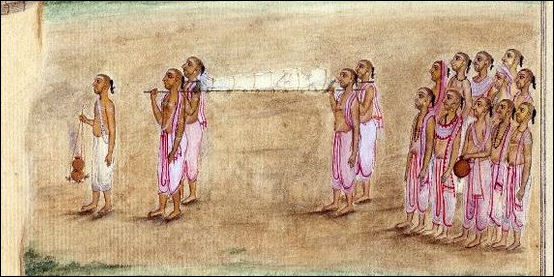
Hindu funeral
 According to Hindu theology an atman (an internal self or soul) dwells in each person as a kind of cosmic energy that exists beyond worldly reality and karma and doesn’t require good deeds or prayers to improve on itself. The problem is that few creatures can tune into their atman and thus require deeds and prayer to help them establish their place in the world Reincarnation helps them do this and evolve to reach closer to their atman.
According to Hindu theology an atman (an internal self or soul) dwells in each person as a kind of cosmic energy that exists beyond worldly reality and karma and doesn’t require good deeds or prayers to improve on itself. The problem is that few creatures can tune into their atman and thus require deeds and prayer to help them establish their place in the world Reincarnation helps them do this and evolve to reach closer to their atman. The cycles of birth and death are perceived a continuations of the disintegrating force of Creation while transmigration of the soul from one life to another is viewed a perpetuation of the separation of the individual from the unifying force of existence. The aim of the individual is to "get off the wheel," to escape the cycle and merge finally with the Oneness that was there before Creation began. into the original One. Methods used on the path of escaping reincarnation include yoga, meditation, and charity. Since the chances of escaping it are quite low people are encouraged to work to achieve a better position in their next life by doing good deeds, living simply and praying a lot.
The cycles of birth and death are perceived a continuations of the disintegrating force of Creation while transmigration of the soul from one life to another is viewed a perpetuation of the separation of the individual from the unifying force of existence. The aim of the individual is to "get off the wheel," to escape the cycle and merge finally with the Oneness that was there before Creation began. into the original One. Methods used on the path of escaping reincarnation include yoga, meditation, and charity. Since the chances of escaping it are quite low people are encouraged to work to achieve a better position in their next life by doing good deeds, living simply and praying a lot. Behavior at the end of one’s life and last thought before dying are believed to be very important in determining how an individual will be reincarnated. Thus a great deal of care goes into making sure a person is well cared before they die and after. This is achieved by creating a calm atmosphere and reading Vedic scriptures and reciting mantras so the soon-to-be-dead can earn as much merit as possible.
Behavior at the end of one’s life and last thought before dying are believed to be very important in determining how an individual will be reincarnated. Thus a great deal of care goes into making sure a person is well cared before they die and after. This is achieved by creating a calm atmosphere and reading Vedic scriptures and reciting mantras so the soon-to-be-dead can earn as much merit as possible.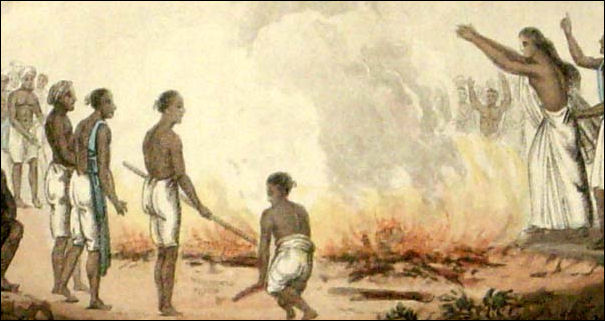
sati, Hindu widow burning herself
Hindu Funeral Customs
 In keeping with the Hindu custom of swift cremation, bodies are cremated within 24 hours after death, if at all possible, even if close relatives can not attend the funeral. Ideally cremation is done within 12 hours after death, or at the very latest before sundown on the next day if death occurs late in the afternoon. The first person families of the dead usually call is the "ice wallah" in the nearby market.
In keeping with the Hindu custom of swift cremation, bodies are cremated within 24 hours after death, if at all possible, even if close relatives can not attend the funeral. Ideally cremation is done within 12 hours after death, or at the very latest before sundown on the next day if death occurs late in the afternoon. The first person families of the dead usually call is the "ice wallah" in the nearby market. Normally the eldest son carries out the funerary rites. He lights the funeral pyre after first placing a burning stick in the mouth of the deceased. One of the primary reasons that Hindus wish for a son is that only sons can carry out funeral rites. It is possible to substitute another relative for a son but this is generally regarded as much less effective.
Normally the eldest son carries out the funerary rites. He lights the funeral pyre after first placing a burning stick in the mouth of the deceased. One of the primary reasons that Hindus wish for a son is that only sons can carry out funeral rites. It is possible to substitute another relative for a son but this is generally regarded as much less effective. There is little mourning when a Hindu dies because they believe that once a person is born he or she never dies. Often there is little crying. Some Indians have said this is because the point of a funeral is to show respect not sadness. Other say it is because Hindu believe the dead are off to a world far better than the one they left behind.
There is little mourning when a Hindu dies because they believe that once a person is born he or she never dies. Often there is little crying. Some Indians have said this is because the point of a funeral is to show respect not sadness. Other say it is because Hindu believe the dead are off to a world far better than the one they left behind. Traditionally women have not been allowed at cremations because they might cry. Their tears like all bodily fluids are regard as pollutants. Women are not supposed to enter the cremation area or even watch what goes on inside it. This includes close relatives and family members. They may help lay out the body at home but carrying the body, gathering the wood and lighting the fire are all considered man's work.
Traditionally women have not been allowed at cremations because they might cry. Their tears like all bodily fluids are regard as pollutants. Women are not supposed to enter the cremation area or even watch what goes on inside it. This includes close relatives and family members. They may help lay out the body at home but carrying the body, gathering the wood and lighting the fire are all considered man's work.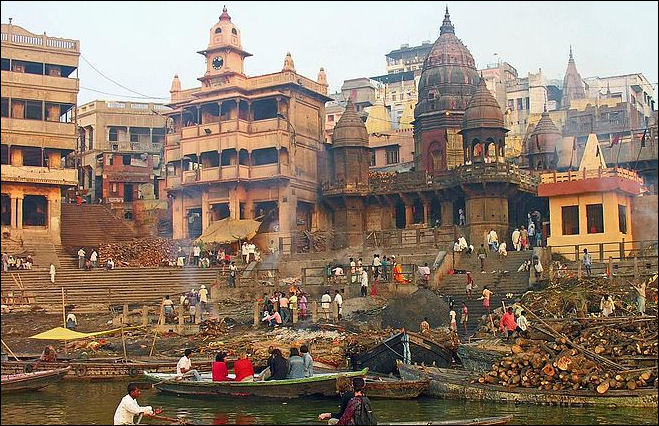
Manikarnika Cremation Ghat in Varanasi
Hindu Preparations for Dying
 When death is imminent the dying person is taken from his bed and laid on the ground, facing south, on a layer of sacred grass. Then a series rites is carried out, presided over by the oldest son or another male relative. These include: 1) the vratodyapana (“completion of the vows”), in which all the vows that the dying has not yet complected are magically completed and ten gifts are made in the name of the dying in one last effort to earn merit ; 2) savraprayascitta (“atonement for everything”), in which is a cow is donated to Brahma to absolve the dying of all his sins and guarantee he or she is carried over the river into heaven; and 3) a ritual bath in holy water from the Ganges.
When death is imminent the dying person is taken from his bed and laid on the ground, facing south, on a layer of sacred grass. Then a series rites is carried out, presided over by the oldest son or another male relative. These include: 1) the vratodyapana (“completion of the vows”), in which all the vows that the dying has not yet complected are magically completed and ten gifts are made in the name of the dying in one last effort to earn merit ; 2) savraprayascitta (“atonement for everything”), in which is a cow is donated to Brahma to absolve the dying of all his sins and guarantee he or she is carried over the river into heaven; and 3) a ritual bath in holy water from the Ganges. When death occurs verses from the Vedas should be recited in the ear of the dying. Behavior at the end of one’s life and last thought before dying are believed to be very important in determining how an individual will be reincarnated. Thus a great deal of care goes into making sure a person is well cared before they die and after. This is achieved by creating a calm atmosphere and reading Vedic scriptures and reciting mantras so the soon-to-be-dead can earn as much merit as possible. It is believed that if a person’s final thoughts are angry or disturbed he may end up in hell.
When death occurs verses from the Vedas should be recited in the ear of the dying. Behavior at the end of one’s life and last thought before dying are believed to be very important in determining how an individual will be reincarnated. Thus a great deal of care goes into making sure a person is well cared before they die and after. This is achieved by creating a calm atmosphere and reading Vedic scriptures and reciting mantras so the soon-to-be-dead can earn as much merit as possible. It is believed that if a person’s final thoughts are angry or disturbed he may end up in hell.Preparations Before a Cremation

Preparation for cremation of Brahmin corpse
 Family members have traditionally prepared the body of the deceased. Before cremation, the body is wrapped and washed, with jewelry and sacred objects intact, in a plain sheet. A red cloth is used for holy people. Married women are buried in their wedding dress and an orange shroud. Men and widows have a white shroud.
Family members have traditionally prepared the body of the deceased. Before cremation, the body is wrapped and washed, with jewelry and sacred objects intact, in a plain sheet. A red cloth is used for holy people. Married women are buried in their wedding dress and an orange shroud. Men and widows have a white shroud. Later the body is dressed in fine clothes and the nail are trimmed and thumbs are tied together while scriptures are read. Often some leaves of the Tulasi tree and few drops of sacred water are placed in the mouth of the deceased. In ancient times the funeral bed was made from rare wood and antelope skin. These days it is made from bamboo or common kinds of wood and no animal skins are used.
Later the body is dressed in fine clothes and the nail are trimmed and thumbs are tied together while scriptures are read. Often some leaves of the Tulasi tree and few drops of sacred water are placed in the mouth of the deceased. In ancient times the funeral bed was made from rare wood and antelope skin. These days it is made from bamboo or common kinds of wood and no animal skins are used. While the corpse is in the house no family member or neighbor can eat, drink ir work. Hindus don’t like it when non-Hindus touch the corpse so an effort is made make sure that any non-Hindus who touch a copse at a hospital are wearing rubber gloves. In the old days the body was disemboweled, fecal matter was removed and the abdominal cavity was filled with ghee or some other pure substance. But this is no longer done. Autopsies are regarded as extremely offensive. Some customs vary according to caste, cultural background and region from which the funeral participants are from.
While the corpse is in the house no family member or neighbor can eat, drink ir work. Hindus don’t like it when non-Hindus touch the corpse so an effort is made make sure that any non-Hindus who touch a copse at a hospital are wearing rubber gloves. In the old days the body was disemboweled, fecal matter was removed and the abdominal cavity was filled with ghee or some other pure substance. But this is no longer done. Autopsies are regarded as extremely offensive. Some customs vary according to caste, cultural background and region from which the funeral participants are from. After the body has been prepared it is carried by male relatives on a flower-draped bamboo bier to the cremation ghats. There is no coffin. Sometimes if the deceased died on an inauspicious day the body is taken out of the house through a hole in a wall rather than the doorway. Male relatives that carry the shrouded body chant “Rama nama satya hai,” the name of the God of Truth. The eldest son is in the lead. He has been purified in a special ritual and carries a fire kindled in the home of the deceased. The fire is carried in a black earthen pot. If the procession is near the Ganges the body is immersed in the river before being placed on the funeral pyre.
After the body has been prepared it is carried by male relatives on a flower-draped bamboo bier to the cremation ghats. There is no coffin. Sometimes if the deceased died on an inauspicious day the body is taken out of the house through a hole in a wall rather than the doorway. Male relatives that carry the shrouded body chant “Rama nama satya hai,” the name of the God of Truth. The eldest son is in the lead. He has been purified in a special ritual and carries a fire kindled in the home of the deceased. The fire is carried in a black earthen pot. If the procession is near the Ganges the body is immersed in the river before being placed on the funeral pyre.Hindu Cremation
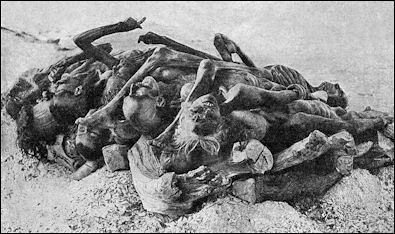
Common fire for poor
 Cremations take place at special cremation grounds. The body is anointed with ghee (clarified butter). Men are sometimes cremated face up while women are cremated face down. The funeral pyre is often made of corkwood and offerings of camphor, sandalwood and mango leaves. A typical pyre is made of 300 kilograms or so of wood. Rich families sometimes pay for the entire pyre to be made up of sandalwood. In Kerala mango wood is often used. because wood is scarce and expensive. Some poor families use cow dung instead of wood. In any case, wood is usually piled on the pyre until only the head is visible. Mantras are recited to purify the cremation grounds and scare away ghosts. Offerings are made to Agni, the fire god, at an altar.
Cremations take place at special cremation grounds. The body is anointed with ghee (clarified butter). Men are sometimes cremated face up while women are cremated face down. The funeral pyre is often made of corkwood and offerings of camphor, sandalwood and mango leaves. A typical pyre is made of 300 kilograms or so of wood. Rich families sometimes pay for the entire pyre to be made up of sandalwood. In Kerala mango wood is often used. because wood is scarce and expensive. Some poor families use cow dung instead of wood. In any case, wood is usually piled on the pyre until only the head is visible. Mantras are recited to purify the cremation grounds and scare away ghosts. Offerings are made to Agni, the fire god, at an altar. Possessions of the deceased are often placed on the pyre. Death is believed to be contagious and it is thought that contact with these possessions could cause death. Sometimes a wife climbs on the pyre and climbs off before the fire is lit, an acknowledgment of suttee (wife-burning) custom without actually carrying it out. Sometimes goats is circled around the pyre three times and given to Brahmins. This symbolizes an ancient cow sacrifice.
Possessions of the deceased are often placed on the pyre. Death is believed to be contagious and it is thought that contact with these possessions could cause death. Sometimes a wife climbs on the pyre and climbs off before the fire is lit, an acknowledgment of suttee (wife-burning) custom without actually carrying it out. Sometimes goats is circled around the pyre three times and given to Brahmins. This symbolizes an ancient cow sacrifice. The eldest son or youngest son— often with his head shaved and wearing a white robe out of respect— usually lights the fire. Before this is done the shroud of the deceased is cut and the body smeared with ghee and a brief disposal ceremony is led by a priest. The son lights a torch with the fire from the black earthen pot and takes the torch and a matka (clay pot with water) and walks around the pyre seven times. Afterwards the matka is smashed, symbolizing the break with earth. The torch is used to light the funeral pyre: at the foot of a deceased woman or at the head of a deceased man. The Brahmin priest reads sacred verses from the Garuda Purana, speeding the dead person’ soul to the next life.
The eldest son or youngest son— often with his head shaved and wearing a white robe out of respect— usually lights the fire. Before this is done the shroud of the deceased is cut and the body smeared with ghee and a brief disposal ceremony is led by a priest. The son lights a torch with the fire from the black earthen pot and takes the torch and a matka (clay pot with water) and walks around the pyre seven times. Afterwards the matka is smashed, symbolizing the break with earth. The torch is used to light the funeral pyre: at the foot of a deceased woman or at the head of a deceased man. The Brahmin priest reads sacred verses from the Garuda Purana, speeding the dead person’ soul to the next life.Burning of the Body During Hindu Cremation
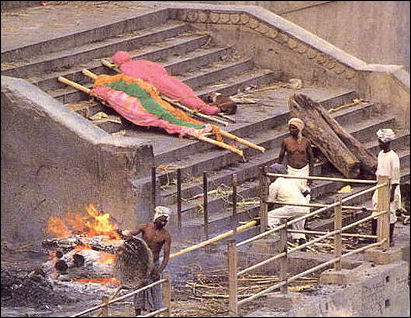
 As the pyre burns the mourners jog around the fire without looking at it, chanting "ram nam sit hair: ("God's name is truth") in the inauspicious clockwise direction. The priest intones; “Fire, you were lighted by him, so may he be lighted from you that he may in the regions of celestial bliss.” It takes about three or four hours for a body to burn.
As the pyre burns the mourners jog around the fire without looking at it, chanting "ram nam sit hair: ("God's name is truth") in the inauspicious clockwise direction. The priest intones; “Fire, you were lighted by him, so may he be lighted from you that he may in the regions of celestial bliss.” It takes about three or four hours for a body to burn. The fire is left to burn itself out. In that time the body is transformed to ashes, and it is hoped the skull explodes to release the soul to heaven. When the fire has cooled, if the skull has not cracked open spontaneously, the oldest son splits it in two. If the cremation is done near the Ganges the bones and ashes are thrown into the Ganges.
The fire is left to burn itself out. In that time the body is transformed to ashes, and it is hoped the skull explodes to release the soul to heaven. When the fire has cooled, if the skull has not cracked open spontaneously, the oldest son splits it in two. If the cremation is done near the Ganges the bones and ashes are thrown into the Ganges. Few tears are shed. The cremation of Indira Gandhi was broadcast around the world. After witnessing her cremation presided over by her son Rajiv, one visiting dignitary asked him , "Could you really do that to your mother?" On the third day after the funeral the cremation bones are thrown into a river, preferably the Ganges, and for ten days rice balls and vessels of milk and libations of water are offered to the deceased.
Few tears are shed. The cremation of Indira Gandhi was broadcast around the world. After witnessing her cremation presided over by her son Rajiv, one visiting dignitary asked him , "Could you really do that to your mother?" On the third day after the funeral the cremation bones are thrown into a river, preferably the Ganges, and for ten days rice balls and vessels of milk and libations of water are offered to the deceased.Hindu Cremations in Varanasi
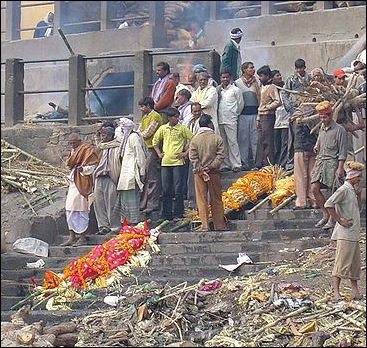
Bodies waiting for cremation
 Varanasi (Banaras, or Benares) is the place every Hindu hopes to be when he or she dies so they can escape the cycle of rebirth and death. If a person dies in the Ganges or has Ganges water sprinkled on them as they breath their last breath it is believed they achieve absolute salvation, escaping the toil of reincarnation to be transported to Shiva's Himalayan version of heaven.
Varanasi (Banaras, or Benares) is the place every Hindu hopes to be when he or she dies so they can escape the cycle of rebirth and death. If a person dies in the Ganges or has Ganges water sprinkled on them as they breath their last breath it is believed they achieve absolute salvation, escaping the toil of reincarnation to be transported to Shiva's Himalayan version of heaven. Cremations have been taking place in the Ganges for thousands of years. Perhaps a 100,000 cremated bodies are thrown in the Ganges every year. In Varanasi, funeral parties wait for their turns on the steps of the ghats (cremation grounds). Bundles carried through the streets are often corpses. On the roads leading to Varanasi you will often see shrouded corpses placed on the roofs of vehicles like surfboards or kayaks. There is even a caste that specializes in sifting through the ashes and mud at the bottom of Ganges for rings and jewelry.
Cremations have been taking place in the Ganges for thousands of years. Perhaps a 100,000 cremated bodies are thrown in the Ganges every year. In Varanasi, funeral parties wait for their turns on the steps of the ghats (cremation grounds). Bundles carried through the streets are often corpses. On the roads leading to Varanasi you will often see shrouded corpses placed on the roofs of vehicles like surfboards or kayaks. There is even a caste that specializes in sifting through the ashes and mud at the bottom of Ganges for rings and jewelry. The processions with the corpse to the ghat are often accompanied by singing, dancing and drumming. They often have a festive atmosphere. Relatives chant “Rama nama satya hai.” The body is immersed once in the Ganges and then anointed with ghee (clarified butter), lashed to a platform and wrapped in bright yellow fabric. The pyre is lit with a flame from a temple. Periodically the embers of the fire pyre are poked by boys with six foot poles to keep the fire burning.
The processions with the corpse to the ghat are often accompanied by singing, dancing and drumming. They often have a festive atmosphere. Relatives chant “Rama nama satya hai.” The body is immersed once in the Ganges and then anointed with ghee (clarified butter), lashed to a platform and wrapped in bright yellow fabric. The pyre is lit with a flame from a temple. Periodically the embers of the fire pyre are poked by boys with six foot poles to keep the fire burning.Description of Cremation in Varanasi
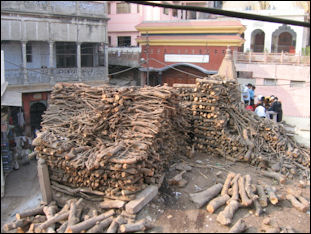
wood for cremation
 Describing the burning ghats at Varanasi in 1933, Patrick Balfour wrote: "Through stagnant water, thick with scum and rotting flowers, we drifted towards the burning ghats, where a coil of smoke rose into the air from a mass of ashes no longer recognizable as a body. One pyre, neatly stacked in a rectangular pile, had just been lit, and the corpse swathed in white, protruded from the middle." [Source: Eyewitness to History, edited by John Carey, Avon, 1987]
Describing the burning ghats at Varanasi in 1933, Patrick Balfour wrote: "Through stagnant water, thick with scum and rotting flowers, we drifted towards the burning ghats, where a coil of smoke rose into the air from a mass of ashes no longer recognizable as a body. One pyre, neatly stacked in a rectangular pile, had just been lit, and the corpse swathed in white, protruded from the middle." [Source: Eyewitness to History, edited by John Carey, Avon, 1987] "An old man surrounded with marigolds, sat cross-legged on the step above. Men were supporting him and rubbing him with oil and sand, he submitted limply to their ministrations, staring, wide-eyed, towards the sun...'Why are they massaging him like that?' I asked the guide...'Because he is dead.'"
"An old man surrounded with marigolds, sat cross-legged on the step above. Men were supporting him and rubbing him with oil and sand, he submitted limply to their ministrations, staring, wide-eyed, towards the sun...'Why are they massaging him like that?' I asked the guide...'Because he is dead.'" "And then I saw them unfold him from his limp position and carry him towards the stack of wood. Yet he looked no more dead than many of the living around him. They put him face downwards on the pyre, turned his shaved head towards the river, piled wood on top of him and set it alight with brands of straw, pouring on him butter and flour and rice and sandalwood."
"And then I saw them unfold him from his limp position and carry him towards the stack of wood. Yet he looked no more dead than many of the living around him. They put him face downwards on the pyre, turned his shaved head towards the river, piled wood on top of him and set it alight with brands of straw, pouring on him butter and flour and rice and sandalwood." "The ceremony was performed with detatchment and a good deal of chat, while uninterested onlookers talked among themselves. When I drifted back, some ten minutes later, the head was a charred bone and a cow was placidly munching the marigold wreathes...The body takes about three hours to burn. Sometime less if more wood is added. The richer a family is the more wood they can afford. While its burning Dom teenager poke at the logs as if it were a campfire. Sometimes cows stand around the fire to get warm.”
"The ceremony was performed with detatchment and a good deal of chat, while uninterested onlookers talked among themselves. When I drifted back, some ten minutes later, the head was a charred bone and a cow was placidly munching the marigold wreathes...The body takes about three hours to burn. Sometime less if more wood is added. The richer a family is the more wood they can afford. While its burning Dom teenager poke at the logs as if it were a campfire. Sometimes cows stand around the fire to get warm.” “When the wood is burned to ashes, the breastbone f the deceased is often still intact. It is given to the eldest son who tosses it in the Ganges. After the family of the deceased leaves Dom children descend on the on the ashes looking for coins, nose studs or gold teeth.”
“When the wood is burned to ashes, the breastbone f the deceased is often still intact. It is given to the eldest son who tosses it in the Ganges. After the family of the deceased leaves Dom children descend on the on the ashes looking for coins, nose studs or gold teeth.”Doms and Hindu Cremation

busy Ghat
 The cremations in Varanasi and other places are preformed by the Doms, a subcaste that makes their living burning bodies for cremations for a fee that ranges considerably depending on the wealth of the family. The Doms are a caste of Untouchables. Touching a corpse after death is viewed as polluting and thus only Untouchables are designated to do this kind of work. So terrible is this work supposed to be the Doms are expected to weep when their children are born and party when death releases them from macabre responsibilities.
The cremations in Varanasi and other places are preformed by the Doms, a subcaste that makes their living burning bodies for cremations for a fee that ranges considerably depending on the wealth of the family. The Doms are a caste of Untouchables. Touching a corpse after death is viewed as polluting and thus only Untouchables are designated to do this kind of work. So terrible is this work supposed to be the Doms are expected to weep when their children are born and party when death releases them from macabre responsibilities. In addition to charging money for performing the cremations the Doms also take a cut from the exorbitantly-priced wood sold near the ghats. The Doms in Varanasi have become very wealthy from their trade and some Indians have accused them of "extortion" over the high prices they charge and the fact they often take money from poor families that struggle to come up with the money for the cremations. Because they are the only ones allowed to perform the cremations, the Doms have established a monopoly and are allowed to charge exorbitant prices because they have no competition. When customers can't pay the full price the Doms are hold back the supply of wood and bodies end up half-burned.
In addition to charging money for performing the cremations the Doms also take a cut from the exorbitantly-priced wood sold near the ghats. The Doms in Varanasi have become very wealthy from their trade and some Indians have accused them of "extortion" over the high prices they charge and the fact they often take money from poor families that struggle to come up with the money for the cremations. Because they are the only ones allowed to perform the cremations, the Doms have established a monopoly and are allowed to charge exorbitant prices because they have no competition. When customers can't pay the full price the Doms are hold back the supply of wood and bodies end up half-burned. In the 1980s the Dom Raja controled the ghats and the supply of wood used to burn the 35,000 or so bodies brought to Ganges in Varanasi for cremations. The Raja did not perform a cremation unless he paid in advance the $45 or so for the wood, and often he demanded an extra payment to guarantee the soul would be liberated. These payments, some claimed, made him the richest man in Varanasi. [Source:Geoffrey Ward, Smithsonian magazine, September 1985]
In the 1980s the Dom Raja controled the ghats and the supply of wood used to burn the 35,000 or so bodies brought to Ganges in Varanasi for cremations. The Raja did not perform a cremation unless he paid in advance the $45 or so for the wood, and often he demanded an extra payment to guarantee the soul would be liberated. These payments, some claimed, made him the richest man in Varanasi. [Source:Geoffrey Ward, Smithsonian magazine, September 1985] Describing an encounter with the Dom Raja, Geoffrey Ward wrote in Smithsonian magazine: "The Dom Raja himself sat cross-legged on a string bed inside his darkened room. Eight hangers on sat at his feet around a little table on which rests a brass tumbler and half-empty bottle of clear homemade liquor. The Dom Raja was immensely fat, nearly naked and totally bald. His thick fingers were covered with big gold rings. When he spoke she slurred his words. I had not brought him a handsome gift, he finally mumbled, so he saw no reason to speak further with me." [Source: Geoffrey Ward, Smithsonian magazine, September 1985]
Describing an encounter with the Dom Raja, Geoffrey Ward wrote in Smithsonian magazine: "The Dom Raja himself sat cross-legged on a string bed inside his darkened room. Eight hangers on sat at his feet around a little table on which rests a brass tumbler and half-empty bottle of clear homemade liquor. The Dom Raja was immensely fat, nearly naked and totally bald. His thick fingers were covered with big gold rings. When he spoke she slurred his words. I had not brought him a handsome gift, he finally mumbled, so he saw no reason to speak further with me." [Source: Geoffrey Ward, Smithsonian magazine, September 1985]Remains in the Ganges
 After the cremation the bones and ashes of the deceased are thrown into the Ganges. Even those who are not cremated near the Ganges have their ashes placed there. Rock guitarists Jerry Garcia and George Harrison are among those who had their ashes scattered in the Ganges. In the old days thousands of uncremated bodies were thrown into the Ganges during cholera epidemics, spreading the disease and producing more corpses.
After the cremation the bones and ashes of the deceased are thrown into the Ganges. Even those who are not cremated near the Ganges have their ashes placed there. Rock guitarists Jerry Garcia and George Harrison are among those who had their ashes scattered in the Ganges. In the old days thousands of uncremated bodies were thrown into the Ganges during cholera epidemics, spreading the disease and producing more corpses. Today only bones and ashes are supposed to be scattered in the river. Even so the cremation process, especially among those who can not afford the large amount of wood needed to incinerate the entire body, leaves behind a lot of half burned body parts. To get rid of the body parts special snapping turtles are bred and released in the river that are taught to consume dead human flesh but not bother swimmers and bathers. These turtles consume about a pound of flesh a day and can reach a size of 70 pounds.
Today only bones and ashes are supposed to be scattered in the river. Even so the cremation process, especially among those who can not afford the large amount of wood needed to incinerate the entire body, leaves behind a lot of half burned body parts. To get rid of the body parts special snapping turtles are bred and released in the river that are taught to consume dead human flesh but not bother swimmers and bathers. These turtles consume about a pound of flesh a day and can reach a size of 70 pounds. In the early 1990s, the government built an electric crematorium on the side of the Ganges, in part to reduce the amount of half-burned bodies floating down the river. Even after the system was introduced most people still preferred the traditional method of cremation.
In the early 1990s, the government built an electric crematorium on the side of the Ganges, in part to reduce the amount of half-burned bodies floating down the river. Even after the system was introduced most people still preferred the traditional method of cremation.After the Hindu Cremation
 After the cremation fire is extinguished the focus of the funeral ritual changes to purifying the relatives of the deceased who are looked upon as ritually impure from their exposure to the corpse. If he hasn’t done so already the eldest son or presiding male relative shaves his head and wears a white robe after the cremation. On the day after pyre was lit he often pours milk over pyre.
After the cremation fire is extinguished the focus of the funeral ritual changes to purifying the relatives of the deceased who are looked upon as ritually impure from their exposure to the corpse. If he hasn’t done so already the eldest son or presiding male relative shaves his head and wears a white robe after the cremation. On the day after pyre was lit he often pours milk over pyre. After the cremation family members wash themselves in water in trenches north of the pyre and pass under a cow yoke propped up by branches, and offer a prayer to the sun. They then walk off led by youngest son and don’t look back. In the first stream they encounter they bath while shouting out the name of the deceased. Afterwards they place rice and peas on the ground to confuse ghosts and then walk to a pleasant place and relate stories about the deceased. When they arrive at home they touch several objects— a stone, fire, dung, grain, a seed, oil and water—in proper order to purify themselves before they enter their houses.
After the cremation family members wash themselves in water in trenches north of the pyre and pass under a cow yoke propped up by branches, and offer a prayer to the sun. They then walk off led by youngest son and don’t look back. In the first stream they encounter they bath while shouting out the name of the deceased. Afterwards they place rice and peas on the ground to confuse ghosts and then walk to a pleasant place and relate stories about the deceased. When they arrive at home they touch several objects— a stone, fire, dung, grain, a seed, oil and water—in proper order to purify themselves before they enter their houses.Hindu Mourning Period and Departure of the Soul
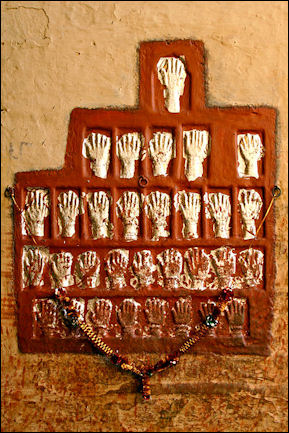
 Hindus believe that the soul exists in a ghost-like state for 10 to 30 days until it is ready to move on to the next stage. For ten to 30 days after a funeral, depending on the caste, the mourners are secluded from society while daily ceremonies. with special ones on 4th, 10th and 14th days, are performed to provide the souls of the deceased with a new spiritual body needed to pass on to the next life. These rites involve offering rice balls and vessels of milk to the deceased. Mourners are expected to refrain from cutting their fingernails, combing their hair, wearing jewelry or shoes, reading sacred texts, having sex and cooking their own food. If not properly performed the soul may become a ghost that haunts its relatives.
Hindus believe that the soul exists in a ghost-like state for 10 to 30 days until it is ready to move on to the next stage. For ten to 30 days after a funeral, depending on the caste, the mourners are secluded from society while daily ceremonies. with special ones on 4th, 10th and 14th days, are performed to provide the souls of the deceased with a new spiritual body needed to pass on to the next life. These rites involve offering rice balls and vessels of milk to the deceased. Mourners are expected to refrain from cutting their fingernails, combing their hair, wearing jewelry or shoes, reading sacred texts, having sex and cooking their own food. If not properly performed the soul may become a ghost that haunts its relatives. After the tenth day, the soul move on and the mourners are regarded as purified. The 12th day after a death has special meaning for Hindus. It is when the soul passes on to the next life. The day is marked by special prayers. A caste dinner is given on the 12th or 13th day after special “ritual of peace” is performed to mark the ending of the mourning period . The ritual involves the chanting of mantras while making a fire and placing four offerings in the fire and touching a red bull.
After the tenth day, the soul move on and the mourners are regarded as purified. The 12th day after a death has special meaning for Hindus. It is when the soul passes on to the next life. The day is marked by special prayers. A caste dinner is given on the 12th or 13th day after special “ritual of peace” is performed to mark the ending of the mourning period . The ritual involves the chanting of mantras while making a fire and placing four offerings in the fire and touching a red bull. The full mourning period lasts two weeks to a year depending on the age of the deceased and the closeness of the relationship to him or her. At the end of a mourning period for his mother a son shaves his head. Sometimes this is done in a river and the hair carried away is a "sign of renewal." When the morning period is complete the eldest son become the head of the family and the wife of a deceased man becomes a widow.
The full mourning period lasts two weeks to a year depending on the age of the deceased and the closeness of the relationship to him or her. At the end of a mourning period for his mother a son shaves his head. Sometimes this is done in a river and the hair carried away is a "sign of renewal." When the morning period is complete the eldest son become the head of the family and the wife of a deceased man becomes a widow. There are restrictions on eating salt, lentils, oil and a number of other foods during the mourning period. Restrictions on the eldest son are even stricter. He often can eat only one meal a day consisting of rice, ghee and sugar and must shave all the hair from his body and conduct hours of rituals and take periodic ritual cold baths for a period of mourning that lasts up to one year.
There are restrictions on eating salt, lentils, oil and a number of other foods during the mourning period. Restrictions on the eldest son are even stricter. He often can eat only one meal a day consisting of rice, ghee and sugar and must shave all the hair from his body and conduct hours of rituals and take periodic ritual cold baths for a period of mourning that lasts up to one year. Rites with offerings known as shaddha are periodically held after a person has died to nourish the soul in the afterlife. The rites are often performed once a year and feature a feast with a plate of food of food offered to the dead. Hindu believe the living must feed the dead living in the World of the Fathers. If the ancestors are properly taken care of they will reward the living with prosperity and sons. The shaddha is thought to day back to the Aryans. It is viewed as a meeting between the living and the dead. The souls of the dead who are nor properly buried are thought live outside the World of Fathers as ghosts that torment their relatives until they are there. custom ["World Religions" edited by Geoffrey Parrinder, Facts on File Publications, New York]
Rites with offerings known as shaddha are periodically held after a person has died to nourish the soul in the afterlife. The rites are often performed once a year and feature a feast with a plate of food of food offered to the dead. Hindu believe the living must feed the dead living in the World of the Fathers. If the ancestors are properly taken care of they will reward the living with prosperity and sons. The shaddha is thought to day back to the Aryans. It is viewed as a meeting between the living and the dead. The souls of the dead who are nor properly buried are thought live outside the World of Fathers as ghosts that torment their relatives until they are there. custom ["World Religions" edited by Geoffrey Parrinder, Facts on File Publications, New York]Hindu Inheritance
 Inheritance was given to this who were obligated to perform shraddha. Since only males can perform the shraddha only they could receive an inheritance. Men without sons could adopt a boy or appoint a daughter, if he had one, to give birth to a boy. Since one male can only serve one the grandson or adopted son gave up the right to perform shraddha to his immediate family. ["World Religions" edited by Geoffrey Parrinder, Facts on File Publications, New York]
Inheritance was given to this who were obligated to perform shraddha. Since only males can perform the shraddha only they could receive an inheritance. Men without sons could adopt a boy or appoint a daughter, if he had one, to give birth to a boy. Since one male can only serve one the grandson or adopted son gave up the right to perform shraddha to his immediate family. ["World Religions" edited by Geoffrey Parrinder, Facts on File Publications, New York] The concept of shraddha was an Aryan idea supplanted by the idea of reincarnation but many of its beliefs remain.
The concept of shraddha was an Aryan idea supplanted by the idea of reincarnation but many of its beliefs remain. Village women are given their inheritance at birth because they are not a son.
Village women are given their inheritance at birth because they are not a son.
Image Sources: Wikimedia Commons
Text Sources: World Religions edited by Geoffrey Parrinder (Facts on File Publications, New York); Encyclopedia of the World’s Religionsedited by R.C. Zaehner (Barnes & Noble Books, 1959); Encyclopedia of the World Cultures: Volume 3 South Asia edited by David Levinson (G.K. Hall & Company, New York, 1994); The Creators by Daniel Boorstin; A Guide to Angkor: an Introduction to the Temples by Dawn Rooney (Asia Book) for Information on temples and architecture. National Geographic, the New York Times, Washington Post, Los Angeles Times, Smithsonian magazine, Times of London, The New Yorker, Time, Newsweek, Reuters, AP, AFP, Lonely Planet Guides, Compton’s Encyclopedia and various books and other publications.
No comments:
Post a Comment